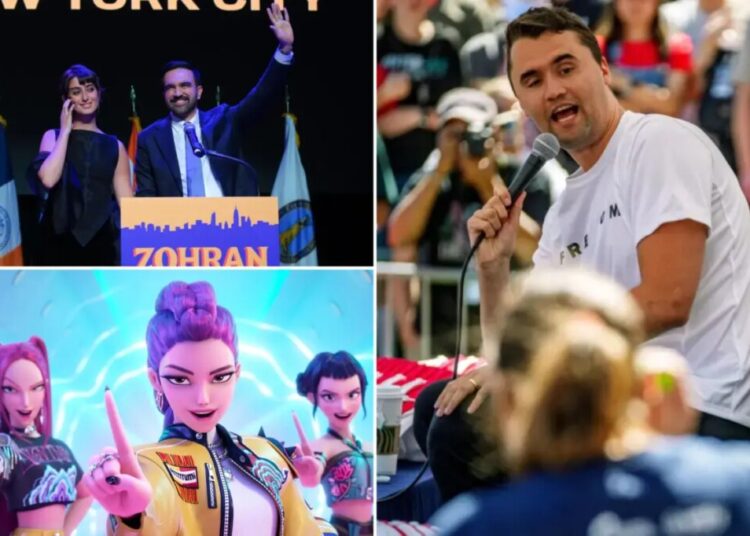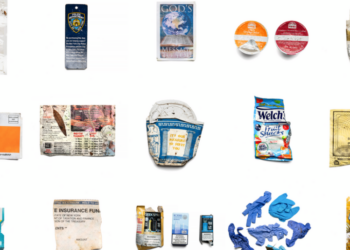Raid entered stomping. But it wasn’t until Laveau Contraire pulled off one of his tentacles that he flipped (literally). Because in a wrestling match between an anthropomorphic giant bug and an influencer-spoofing drag queen, anything goes.
With gold sequins glinting and fringe swishing on her thong leotard, Contraire beat Raid with his own body part — and then turned it on the referee. Raid — a bulging-eyed, scraggly-toothed creature in a singlet, driven to enact revenge for makeup testing and other critter-disrespecting ills — retaliated by slamming her into the ropes. Before long on one recent Tuesday, they were pummeling each other in a 16 x 16 foot ring set up at Pioneer Works, the art space in Brooklyn, as a crowd of 500 cheered.
This is the over-the-top vision of Choke Hole, the queer and drag artist troupe that originated in New Orleans, whose multimedia, high-camp métier is a sharp satire of American culture expressed through W.W.E.-style wrestling.
“It’s an almost stealth way to get people to appreciate art and politics and drag and athletics, all these things that it is,” said Ellery Neon, one of the group’s founders.
Decades beyond the household names of the 1980s (Hulk Hogan, André the Giant) and early 2000s (the Rock, John Cena), pro wrestling remains hugely popular (and profitable). It can still mint stars, marketed as “sports entertainment,” even as it’s dismissed by nonbelievers as commercial fluff.
As a medium, professional wrestling has lately been slicing into the art world, with gallery shows, performances and a forthcoming major museum exhibit. Curators, artists and newfound fans are re-evaluating and embracing it as a genre that’s rich in aesthetic symbolism, cultural history and complex narratives — especially in an era of kayfabe, the term of art for pro-wrestling’s unique mix of inauthentic authenticity.
“I would really love to see people place it in the category of performance art,” said Ebony L. Haynes, the global head of curatorial projects at David Zwirner, the sprawling gallery. In October, Haynes curated a wrestling-themed exhibit and series of matches at 52 Walker, Zwirner’s affiliated downtown performance space.
With some pro wrestlers from the lineup of All Elite Wrestling (A.E.W.), the smaller alternative to the behemoth W.W.E. (World Wrestling Entertainment), and punk bands as openers, the scene one Friday night was high-art hardcore. During his winning tag-team match, Darby Allin, in signature half-skull face paint, scaled one of 52 Walker’s exposed metal columns, his spinal tattoos glistening like an exoskeleton, then leaped and landed on one of his rivals, Timothy Thatcher, 10 feet below. Afterward, Allin left his mark by spitting a mouthful of blood on a gallery wall.
Zwirner, the mega-dealer, conceived of the show as a tribute to his friend and exhibiting artist Raymond Pettibon, a longtime wrestling aficionado. He came away a fan. “It blew my mind,” Zwirner said of the matches. “I will never look at wrestling the same way.”
The athleticism wowed him — the wrestler, Jamie Hayter, flipped her opponent, Billie Starkz, out of the ring, then yanked her back in by her purple pigtails — and so did the chanting interactions between the grapplers and the crowd. “What I didn’t realize is, it’s very scripted, not just onstage, but also the audience knows what’s expected of it,” Zwirner said.
“The violence is theater,” he added. “It’s really kind of a beautiful atmosphere.”
An 11-year veteran of the pro circuit, Allin likened the competitions to Broadway in emotional range and physical stamina. “No performance is the same,” he said. “So, essentially, you have to, like, create a new piece of art every single week.”
At the exhibit, “52W Hardway,” that Friday, Pettibon — hailed as “The Great Raymondo” — presided from a golden throne, his face hidden behind a lucha libre mask. With roots in California punk, he’s retained an outsider’s streak even as his work became highly collectible.Beyond the ring, the gallery’s walls were lined with his drawings of bodies in brawls, a subject he has been depicting since at least the ’80s.
“Wrestling’s influence on art practice goes back to Greco-Roman times, or earlier,” Pettibon said in an email. Nowadays, it should have more crossover, he thought: “To quote Russell Westbrook,” the N.B.A. star, “Why not?”
Fandoms, in sports and beyond, share “a common (but lively, contentious) language,” he said, and pointed to a 1950s Roland Barthes essay to explain wrestling’s enduring appeal. Barthes was all for the spectacle, comparing it to “ancient theater” and commedia dell’arte, and contending that wrestling portrays “a purely moral concept: that of justice.”
Over the years, artists have bounded onto the mats, including Shaun Leonardo, who is known for his paintings and performance dissecting sports and violence, and who developed a luchador alter-ego in the 2000s; and the pioneering cross-disciplinary feminist Rosalyn Drexler, who wrote about a book about her experiences as a pro on the women’s circuit in the ’50s. (It inspired the 1980 movie “Below the Belt.”)
Wrestling’s traditional machismo is punctured in the flamboyant exóticos of lucha libre (Mexican masked fighting) and the robust women’s league in Japan. (Sukeban, a fashion-influenced Japanese female wrestling group, will make a repeat appearance at Miami Art Week this year.) Gender performance has always been exaggerated in pro wrestling, in ways that are ripe — and hilarious — to explore.
“Honey, they’ve already got makeup on, they’ve got short shorts, gold capes, long hair,” said Neon, of Choke Hole. “Throw in some fake boobs and a couple more accouterments, and you’ve got drag.”
Enacting what Neon called “this incredibly hammy American pastime” as queer artists, Choke Hole’s personae amp up the raunch (without sacrificing some of the puns). “I put the diva in deviant,” Neon’s character, Gorlëënyah, a green, three-nosed alien with an expansive bouffant, proclaimed at the show this month.
Beyond gender, the art world’s receptivity to wrestlers may have something to do with the social currency of kayfabe, said Katherine Pill, a senior curator at the Museum of Fine Arts, St. Petersburg, in Florida, which in 2027 will present “House Show,” a 5,000-plus-square-foot exhibition examining professional wrestling. Kayfabe — a term whose murky origins may be pig Latin (the “e” is silent) — entered the Merriam-Webster dictionary in 2023; it describes wrestling’s fierce devotion to illusion as reality. It’s competitive truthiness, and it’s pervasive. (It’s also slippery when it becomes satire, as Choke Hole discovered in real time at a match with an ICE agent character.)
“The thing is, it’s not fake, it’s choreographed,” said Pill. “And it’s a really complicated choreography. Even though you’re fighting one another, you’re also essentially taking care for the other person, right? Because no one wants to truly get hurt.”
The dual life of these professional bruisers is the subject of paintings by the artist and A.E.W. wrestler Lee Moriarty, in which beefy figures in luchador masks bird watch and build snowmen amid feathery pastel landscapes. His first public showing, at the 2024 Nada Art Fair in Miami, sold out, with the Pérez Art Museum acquiring a work for its permanent collection. A solo exhibition at the influential Night Gallery in Los Angeles followed this fall.
Moriarty spent two years in a community college graphic design program, and was otherwise self-taught. “I never painted with the intention of it selling,” he said. He briefly wrestled in Mexico, and his acrylics are a reflection of his own hobbies and temperament. “Outside of the ring, I’m a very calm, introverted person,” he said.
Moriarty’s entree into the art world was shepherded by Adam Abdalla, who curated his Night Gallery showing. Abdalla, who runs a New York PR firm focused on arts and culture (Night Gallery and Pérez Art Museum have both been clients), is a wrestling die-hard — he was trading videotapes of bouts as a 12-year-old in Brooklyn — and has become the de facto art/wrestling kingpin and clearinghouse. In 2020, he founded the journal Orange Crush, whose three issues brought a glossy magazine aesthetic and cerebral essays to the normally downscale world of wrestling publications.
The journal, which he said is currently on pause, ignited enough interest for him to champion artists like Moriarty and Thekla the Toxic Spider (Thekla Kaischauri), an Austrian-by-way-of-Japan A.E.W. star with an M.F.A., whose canvases apply Viennese Expressionism to the cage match.
“There’s always this tension between the high and low that brings new audiences to the arts,” Abdalla said. He now owns a wrestling league in New Jersey and is one of the curators of the exhibit coming to the St. Petersburg museum, where Kaischauri’s work was recently added to the permanent collection.
Choke Hole, which started as an underground party in 2018, is outside his orbit. Their two-night gig in Brooklyn — the artist Raúl de Nieves invited them to be part of his exhibition at Pioneer Works — followed performances at temples of high art, including the Metropolitan Museum of Art and MoMA PS 1. Last year, they also appeared at a Times Square Arts installation of a giant exploding hot dog.
With de Nieves’s soaring, ersatz stained glass windows as a backdrop, they filled a makeshift dressing room with body paint, wigs, and kneepads. The cast included Visqueen, a pink-clad sex robot with a machine gun for a leg; Jassy, a greedy capitalist doyenne susceptible to nipple tweaks; and one unusually buff baby. Over a D.J.’s thumping beats, they somersaulted around the ring, and pounded the mat with elbow drops and airplane spins.
The fan favorite Candy Pain entered with a headstand off the top rope. Props like a four-foot long cigarette and an oversized syringe of facial filler were employed as weapons. The audience jeered the villains, clapped along and often roared in laughter.
Choke Hole’s universe comes complete with a story line about intergalactic gentrifiers, and even an invented sponsor, Squelsh (“the energy drink that calms you down”). But the inclusion of an ICE agent character, introduced as a former Amazon employee who had just lost his job to A.I., was too much for some spectators. As the match concluded — he was handily vanquished by Candy Pain — an audience member rushed onto the stage and protested loudly that ICE raids were not funny.
As the audience absorbed the idea that this wasn’t meant to be part of the show, the referee broke character. The protester was right, he said; ICE was deeply serious. The atmosphere was heavy. Take a breath, he suggested. “We’re living in a time right now where sometimes parody and comedy is going to get us through,” he said. “If it sparks something in you, take that and move something with it.” The crowd cheered.
Choke Hole cut the bit from its subsequent performance and posted a statement of apology. The group donated its profits from the run, $3,542, to the organization NYC Ice Watch. The artists were beside themselves with regret, Neon said, and realized why, in their invented world, this moment caused so much turmoil. “It was too real,” he said.
Back at Pioneer Works, in the staged confines of the ropes, the raucous energy of the night eventually resumed, ending in a melee of nearly a dozen costumed wrestlers tussling, sometimes lasciviously, on the mat. The show was called “Armageddon” — “reporting live from the rubble of America,” a faux newscaster announced. Raid was, of course, the only one left standing.
Sarah Goodman contributed reporting.
Video camera operator: Jensen Gore.
Melena Ryzik is a roving culture reporter at The Times, covering the personalities, projects and ideas that drive the creative world.
The post Body Slams, Curated: Pro Wrestling Enters Its Museum Era appeared first on New York Times.




